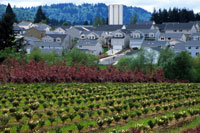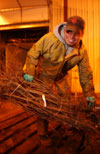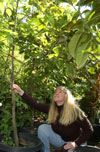An Industry Blooms in Portland

Stand in the middle of downtown Portland and look around. You’ll see tall buildings, cars and people, pretty much what you’d expect in Oregon’s biggest city and surrounding metropolitan area—home to more than 80 percent of the state’s 3.4 million residents.
But hang on a minute. There’s more out there. It just might surprise you to know that the Portland metro area, spread across Multnomah County and parts of Washington and Clackamas counties, is a major agricultural production center.
Sprinkled between the boulevards and neighborhoods, mostly at the fringes of the metro area, are hundreds of nurseries and greenhouse operations that are part of the state’s top-earning agricultural enterprise—the nursery and greenhouse industry.
Ornamental shrubs, trees and flowering plants are Oregon’s number one agricultural product. Growers here produce more than 3,000 varieties of plants—everything from annual and perennial flowers, flowering landscape trees, and conifer trees and shrubs, to ground covers, ornamental grasses and wetland aquatic plants.
In 2001 Oregon’s nursery and greenhouse industry grossed $842 million in farm-gate sales. About three-fourths of the state’s nursery-greenhouse production is exported to the rest of the United States. The remaining 25 percent is marketed here.
The state has more than 2,000 nursery-greenhouse operations, mostly concentrated in the north Willamette Valley. Tucked in among them just south of Wilsonville, 18 miles from downtown Portland, is the North Willamette Research and Extension Center (NWREC), one of Oregon State University’s major regional research and education outposts.
 |
 |
|
|
OSU's Neil Bell evaluates a field trial of Ceanothus at the Oregon Garden near Silverton, to see which varieties are best suited to the Willamette Valley climate. Photo: Bob Rost |
A new housing development southeast of Portland sprouts next door to a commercial nursery. Photo: Steve Dodrill |
Situated on 159 acres of prime farmland near the Willamette River, NWREC is home base for a team of OSU Agricultural Experiment Station researchers and OSU Extension Service educators who support the nursery-greenhouse industry, and the berry and vegetable crop industries in the region as well.
The center, established in 1965, and Oregon’s nursery and greenhouse industry have enjoyed a long and productive relationship.
"Serving industry needs through research and education has always been a top priority," said Del Hemphill, superintendent of the research center. "It’s a very big part of the reason we’re here. We work closely with the growers to identify ways we can help them and they help us by funding many research projects at the center through their grower associations and commissions."
Scientists in the OSU Department of Horticulture on campus in Corvallis also conduct research in support of the industry and work closely with their colleagues at NWREC.
The industry’s success in Oregon, and nationally—more than $10 billion in nursery-greenhouse products sales in 2001—apparently boils down to one simple fact: people love plants. Gardening is one of America’s highest rated leisure-time activities.
Even in recent years, when the U.S. economy began to sputter, consumers bought fewer cars and refrigerators, but they continued to spend, spend, spend on landscape and garden plants, shrubs and trees.
 |
 |
|
|
Inside the Carlton Plant's cold-storage warehouse, Juan Carlos Guerrero loads a bareroot serviceberry shrub for shipment to the Midwest. Photo: Lynn Ketchum |
OSU nursery crops specialist Richard Regan looks up as panels slide open on the retractable-roof greenhouse at NWREC. Photo: Bob Rost |
Well over half of American households—60 million-plus—bought nursery and greenhouse products every year through the late 1990s, according to recent National Garden surveys. There’s no indication that the public’s love affair with plants is waning.
According to the Roper Report published recently in American Demographics magazine, 44 percent of Americans garden to be outdoors and 42 percent report they garden to be around beautiful things.
The beauty of ornamental plants as a measure of their worth can’t be overemphasized. The aesthetic appeal, form and color and even fragrance of plant products is the key to marketing success. Even plant names are fascinating. For example, would you be interested in a planting of Dinosaur Food, Bear’s Breeches, Monkshood, Lady’s-Mantle, Painted Lady Fern, Goat’s Beard, Chameleon Plant, Ozark Sundrops or African Daisy?
Apparently, the majority of us find all of this ornamental plant charisma, charm and glamour impossible to resist.
"It’s important to remember that nursery and greenhouse farmers are in business to sell a living product that consumers want because it is healthy, vigorous and beautiful," said Richard Regan, an OSU Extension Service field faculty member at NWREC. "To stay competitive, growers have to work towards producing the highest quality possible in every plant. Efficient water and fertilizer management, and pest insect and weed control are essential to achieving that."
For Regan and his NWREC colleagues, helping the industry improve production efficiency is more important than ever, not only because of keen competition within the industry, but also because nursery and greenhouse growers face growing competition for the very land they farm.
Steady population growth has put increasing development pressure on many Oregon nurseries in the Portland metro area and in Marion County around Salem.
The latest ripple in this trend is a plan to expand the Portland metropolitan area’s urban growth boundary by 18,600 acres. The expansion will allow more than 38,000 new dwelling units and affect many nursery operations in the area. Some will sell their farms and relocate. Others, like it or not, will be getting new neighbors.
"Nursery and greenhouse operations are usually the last agricultural enterprises to survive in areas where urban development is spreading," Regan said. This tends to happen because many of these operations are on small acreages and the owners sell their products locally, he added.
The struggle for land between development and production agriculture is prelude to another battle—the fight for water. Homes and businesses need water and so do crops. The standoff has led to water management becoming a high profile issue in the industry.
Growers are turning to new precision irrigation methods. Regan and other NWREC staff are evaluating the efficiency of subirrigation and micro-irrigation systems for field and container nursery crops and greenhouse production.
Both approaches are a departure from the sprinkler irrigation systems many nurseries have used over the years. Subirrigation is a network of specially designed perforated tubing that is installed in the field, or other types of planting beds. Water is delivered directly to plant roots. The tubing is disposable. When plants are harvested, the subirrigation system may be removed and discarded. A new system is re-established when the field is replanted.
 |
 |
|
|
Weeds are a major problem in the nursery and greenhouse industry. James Altland, an OSU Extension weed specialist, studies what influences weed growth in plant containers. Photo: Bob Rost |
The Willamette Valley's Wooden Shoe Bulb Company opens its rainbow fields to the public every spring. Photo: Lynn Ketchum |
"Micro-irrigation is used with large-size container plants," Regan explained. "This system delivers water directly to containers through a network of tubes with water emitters attached. Each water emitter delivers water to an individual container."
Researchers and Extension faculty are field testing both systems to evaluate their application for different types of planting situations. Studies show that precision irrigation promotes uniform growth of nursery crops and provides much greater control over distribution of irrigation water, which allows growers to apply their limited water resources as efficiently as possible.
Increasing irrigation efficiency is important, but it’s still only part of the production battle. Pest insects and weeds are a constant threat to nursery and greenhouse crop quality.
"Growers have pretty much a zero tolerance for insect injury on plants because even the smallest amount of pest insect-caused damage can reduce the market value of plant products," said Robin Rosetta, an OSU Extension field faculty member and Integrated Pest Management specialist at NWREC.
Achieving almost total control over pest insects is difficult, but Rosetta helps growers work towards that goal through application of Integrated Pest Management (IPM) techniques.
IPM consists of a combination of methods. These include biological control (or bio-control), the use of predator insects to control pest insects; and cultural practices, the process of how a plant is grown—fertilized, irrigated and cultivated. Although IPM strategies don’t exclude using chemical controls, the basic IPM goal is to achieve long-term prevention of insect pests without reliance on pesticides.
"The initial step in IPM is to learn as much as possible about the target pest insect," said Rosetta. "This allows the grower to choose the best IPM strategy for control. Sometimes there is a large amount of information already available on insect pests that concern our growers. When information isn’t available, staff at NWREC conduct field research on the pest insect of interest to learn more about its life cycle, feeding habits and mobility.
"There are always potentially troublesome insect pests around," Rosetta added. "The honey locust pod gall midge has been a concern but we’ve developed a good management strategy for it. Whiteflies and thrips in greenhouse production are a growing problem, and root weevils are an ever-present threat in broadleaf evergreen and container plant production."
 |
 |
|
|
Robin Rosetta, OSU pest management specialist, looks for signs of pest damage on container trees at Cousin's Nursery near Salem. Rosetta helps growers conduct field monitoring to detect pests early. Photo: Bob Rost |
Micro-irrigation systems deliver water to individual containers through a network of tubes attached to emitters in the soil. Photo: Bob Rost |
Bio-control of insect pests is attracting more interest among growers, according to Rosetta. For example, she is evaluating the use of predator mites to control spider mites on various types of nursery plants.
"Bio-control is an important tool but it isn’t the answer in every case," said Rosetta. "The philosophy of IPM is to choose the best insect control alternative for the particular problem at hand and fine-tune that strategy as needed to achieve the best possible control."
IPM strategies are also effective for weeds, a nuisance in the industry every bit as prevalent as insect pests.
Weeds compete with cultivated plants for water and nutrients, reducing the health and vigor of economically important crops.
Many types of weeds, including liverwort, pearlwort, fireweed, prostrate spurge and common groundsel, are likely to show up in nursery container plants.
James Altland, OSU Extension field faculty member, is leading efforts at NWREC to help nursery and greenhouse growers keep their operations as weed-free as possible. He currently is studying effects of fertilizer placement for weed control in container crops.
Altland experimented with three treatments to determine which offers the best weed control in container plants. The three treatments were top-dressing (sprinkling fertilizer on the soil surface), incorporation (mixing fertilizer into the planting soil) and dibbling (placing a concentration of fertilizer just below the plant roots).
"So far," Altland noted, "dibbling appears to be effective, not only in reducing weed growth, but also in promoting vigorous growth in the container plants.
"Weed growth, whether in field-planted crops or in containers, is always influenced by cultural practices," said Altland. "Growers can usually improve weed control by fine-tuning their fertilization and irrigation practices. Figuring out the fine-tuning process is the key to success. It’s a little different for every crop and planting situation."
Whether it’s weeds, insect pests or irrigation efficiency, the overarching theme in addressing these issues is the same. Achieving better control over the problem leads to improved product quality. It’s a philosophy researchers are applying structurally, as well as biologically.
NWREC staff, with help from industry and the Oregon Economic Development Commission, recently built a retractable-roof greenhouse at the center.
"The retractable roof is an important innovation because it lets growers control the environment around greenhouse crops," said Sven Svenson, former OSU Agricultural Experiment Station researcher at NWREC. "They can pop open the roof at any time to let the outdoor climate displace the indoor conditions of the house."
Retractable roof technology is attracting attention because it increases energy efficiency and plant quality, according to Svenson.
Energy costs are high in traditional greenhouses because ventilating systems are needed during the warmer months to moderate internal temperatures. The ability to open the roof eliminates this problem.
The retractable roof also lets growers easily acclimate greenhouse crops to the outdoor environment. Many types of plants produced in greenhouses are intended for outdoor use and have to be acclimated to outdoor conditions before they are marketed.
Many Oregon growers are now using retractable roof greenhouses. According to Hemphill, the success of the project is a great example of how much can be accomplished in cooperative efforts with the industry.
As the industry continues to grow, NWREC staff have turned to a technology solution of their own to respond to increasing information and education needs.
"The number of growers, particularly those on small acreages, have increased dramatically over the past decade," said Rosetta. "We still offer the traditional workshops and field days, but we’re relying more on the World Wide Web to deliver research and education information. It’s an important way for us to address a growing demand for our programs with reduced staff resources."
Rosetta is confident that online delivery will be useful for the greenhouse and nursery audience. After all, most of them are city folks, farming the edge of the Portland metro area.
For more information about OSU Agricultural Experiment Station and Extension Service programs in support of the nursery and greenhouse industry see these Web sites:
